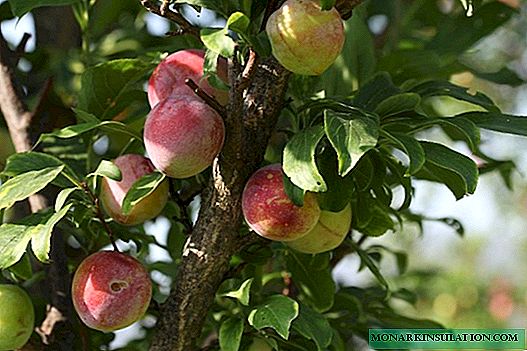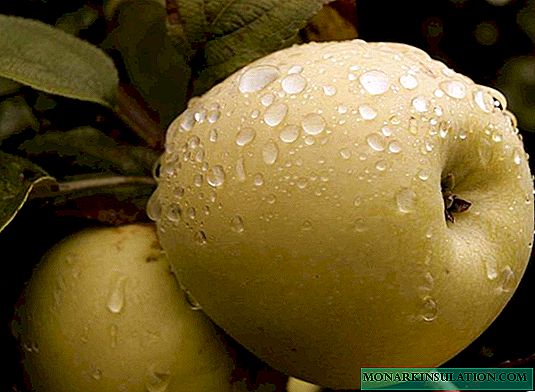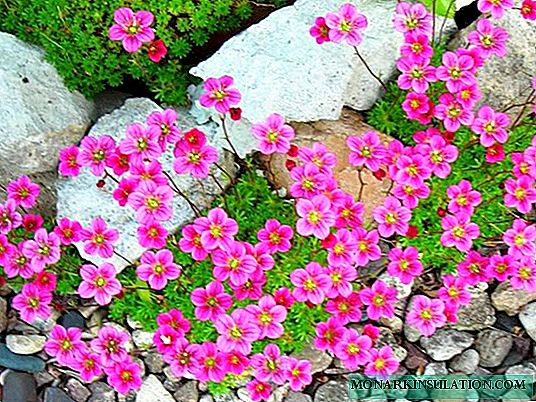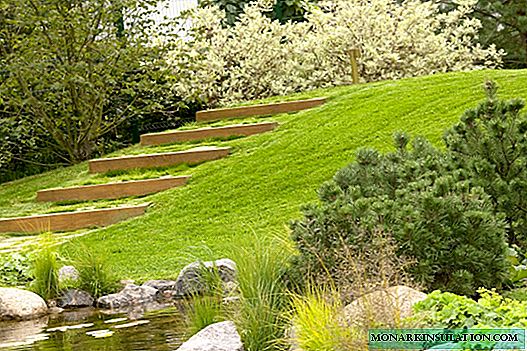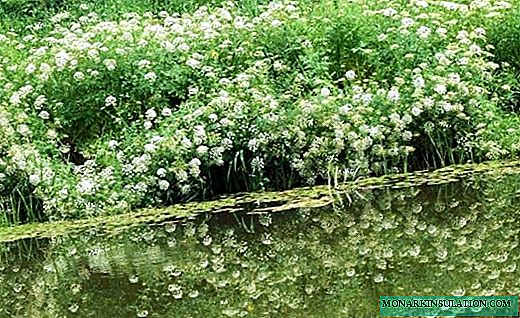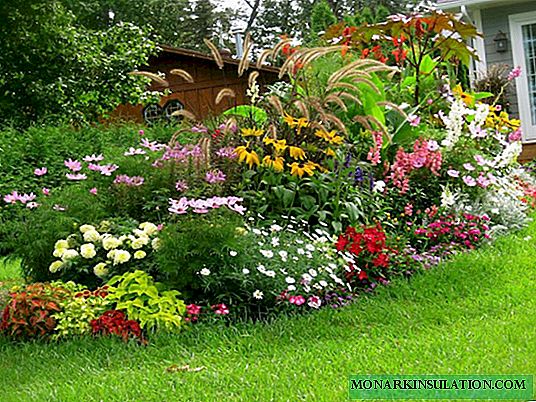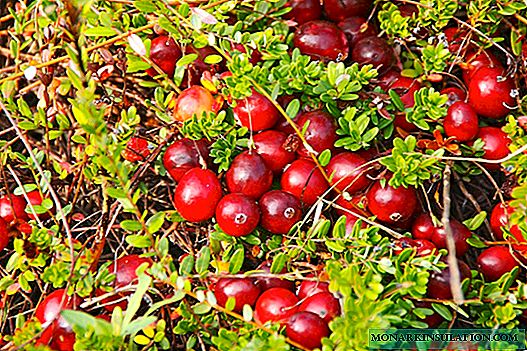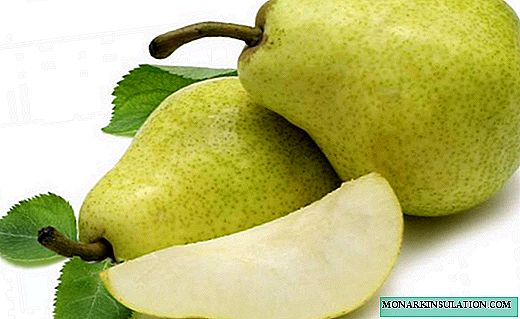
Pear is one of the oldest fruit crops. Mankind has created thousands of varieties of this tree. It is difficult to navigate in such a sea of information. Variety Moskvichka is one of the most common in Central Russia, especially in Moscow and the Moscow Region. Get to know him better.
Grade description
Obtained in 1979 at the Moscow Agricultural Academy by the method of free pollination of an old American pear of the Kiffer variety. Muscovite surpassed the parent in taste of fruits and winter hardiness, adopted from him early maturity, productivity, autumn ripening. The variety was included in the State Register in 2001 and zoned in the Middle Volga, Volga-Vyatka and Central regions. Widely distributed in Moscow and the Moscow region.
Free pollination is a breeding method in which seedlings are used from seeds of the parental variety, freely pollinated by bees. This is the easiest selection method with unpredictable results.
The variety has a medium-tall standard tree with a dense conical crown, which is formed by oblique-vertical skeletal branches with a light gray bark. The growth of shoots is moderate. Unfortunately, it was not possible to find in the sources - on what types of fouling twigs Moskvichka bears fruit. Winter hardiness of the variety is average, late flowering. The variety has good immunity to scab and fruit rot. High early maturity compared to other varieties of pears - in the third and fourth year after planting, you can count on the first crop. The ability to self-pollination is absent. The best pollinators for Muscovites are pears of varieties Lyubimitsa Yakovleva and Bergamot Moscow.
Pear Muscovite autumn consumption period - depending on the season, the fruits ripen from the beginning to the end of September. Shedding fruit is weak. Productivity is stable, average. One tree produces about 35 kilograms of fruit; on an industrial scale, the average yield is 126.5 c / ha. Fruits are stored for 25-30 days, and according to the VNIISPK (All-Russian Institute for the Selection of Fruit Crops), up to 80-100 days can be stored at 0 ° C, average transportability.
Fruits are roundly broadly conical and broadly obovate in heterogeneous size. The average weight of one fruit is 130 grams. The skin color when removed is greenish yellow, with many small, pronounced subcutaneous dots. Often there is quite a strong rusting, sometimes there is a faint, barely noticeable blush. The skin is thin, dense, oily. The flesh is yellowish-white, juicy, semi-oily, fine-grained. The taste is sour-sweet, pleasant, with a strong pear aroma. The presentation of the fruit is excellent, the purpose is universal, the variety is of commercial interest.

The skin color of the pear Muscovite when picked up is greenish-yellow, with many small, pronounced subcutaneous dots
Planting a pear variety Moskvichka
A pear will grow well and bear fruit abundantly only if favorable conditions are created for it. A pear of any kind will feel better on a small south or southwest slope, protected from the north or northeast from cold winds. Such protection can be tall trees, a fence or a wall of a building. It is necessary to plant a pear at a certain distance from these barriers so that it does not appear in a deep shadow. A pear loves the sun and will bloom only in good light. In marshy places and in places with a close location of groundwater, the pear will not grow - it has a great tendency to root out the root and the stem. The soil should be loose and drained. In composition, soils rich in humus are better suited; on poor sandy and sandy loamy soils, a pear can be grown only by planting large pits (1-1.5 m3) volumes filled with fertile nutrient mixture. The acidity of the soil should be in the range of pH 5.5-6, it is possible and pH 4.2-4.4, but on alkaline pears it hurts and cannot grow. The distance between adjacent trees in a row should be observed within 4-4.5 meters, and between the rows the distance should not be less than 5 meters. With this planting scheme, good ventilation and illumination of tree crowns will be achieved, as well as conditions will be created for the convenience of maintenance and harvesting.

The distance between adjacent trees in a row should be observed within 4-4.5 meters, and between the rows the distance should not be less than 5 meters
In regions where the Moscow pear is zoned, only early spring planting of seedlings is acceptable. Trees planted in autumn, as a rule, do not have time to take root and grow stronger - as a result, they cannot survive the winter and die. In the spring, they choose a time when sap flow has not yet begun, but the soil has already warmed up enough and the buds are about to start growing. When planting, seedlings should be in a dormant state.
Seedlings with a closed root system can be planted at any time - from April to October.

Seedlings with a closed root system can be planted at any time - from April to October
Experienced gardeners do not postpone the acquisition of seedlings until spring. They know that the best choice of planting material is in the fall. At this time, nurseries massively dig seedlings for sale, and in the spring they will sell what remains of the fall. The main criteria for choosing a seedling are the age and condition of the root system. Recommended age is one to two years. At an older age, trees take root worse and later bear fruiting. This rule does not apply to seedlings with a closed root system. Sapling roots should be well developed, without growths and cones. On trunks and branches, the bark should be smooth, healthy, without cracks and damage.

The root system of the seedling should be well developed, without growths and cones
Before spring, the seedling should be dug in the garden so that it is well preserved. This simple process is as follows:
- Dig a small hole in the ground about a meter long and 0.3-0.4 meters deep.
- A layer of sand is poured into the bottom.
- The roots of a seedling are dipped in a solution of mullein and clay with the consistency of liquid sour cream (the so-called talker) and dried slightly. Such a coating will prevent the roots from drying out.
- Stack the seedling obliquely. The roots are placed on the sand, and the top is placed on the edge of the pit.
- They fill the roots with sand and water it.
- When the cold comes, they fill the pit with earth to the top, leaving only the top of the tree on the surface.
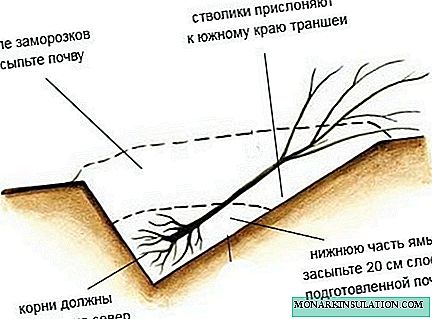
Sapling before spring should be dug in the garden so that it is well preserved.
You can also save the seedling in the basement at a temperature of 0 to +5 ° C, creating a moist environment for the roots.
Landing pit should also be prepared in the fall. This is an important stage and should be taken seriously. Of course, if the landing is carried out on black soil rich in humus, then the issue of the quality of the landing pit is not relevant. But as a rule, such conditions are rare. Therefore, you need to do this:
- Dig a hole 70-80 centimeters deep. The diameter can be 80-100 centimeters. On sandy soils, these sizes are made even larger. If the upper layers of the soil are fertile - they can be laid aside for future use.
- On heavy soils, drainage should be provided. To do this, a layer of rubble, gravel or broken brick is poured onto the bottom of the pit. Layer thickness - 10-15 centimeters. On sandy soils, instead of drainage, a clay layer is laid to hold water.
- Prepare a nutrient mixture. To do this, take chernozem (you can use fertile soil, deposited when digging a hole), peat, humus and sand. These components are taken in approximately equal parts. Then add 300-400 grams of superphosphate, 3-4 liters of wood ash and mix well.
- They fill the pit with a nutrient mixture to the top and cover it with a roofing material or a film so that melt water does not wash out the nutrients.

Pit filled with nutrient mixture to the top
Step-by-step instructions for planting a pear Moskvichka
When the time comes, they begin to plant the pear:
- A seedling is taken from the storage place and inspected. If there are damaged and dried roots - cut them out.
- For several hours, the roots in the water are soaked with the addition of Heteroauxin, Kornevin, Epin or another growth stimulator and root formation.
- Open the landing pit and take out part of the soil from it so that a pit of sufficient size is formed in the center to position the seedling root system in it.
- 10-12 centimeters from the center they drive a wooden stake (you can use a metal pipe or rod) with a height equal to one meter above ground level.
- An earthen mound is poured and a seedling is placed on it, placing the root neck at the top, and the roots are straightened along the slopes.
- Then they fill up the hole with the taken out nutrient mixture to the top, while trying to ram in layers.
- After backfilling and tamping, the root neck of the seedling should be 3-5 cm above the soil level. In the future, after irrigation, the soil will settle and the root neck will drop to ground level - this is what is needed.

The root neck should be at ground level
- Next, you need to form a near-stem circle, raking the earthen roller with a chopper or plane cutter along the diameter of the landing hole.
- Tie the tree trunk to the peg with elastic material in the form of an "eight."
- They moisturize the soil well so that it fits snugly to the roots and there is no air sinus left in it.
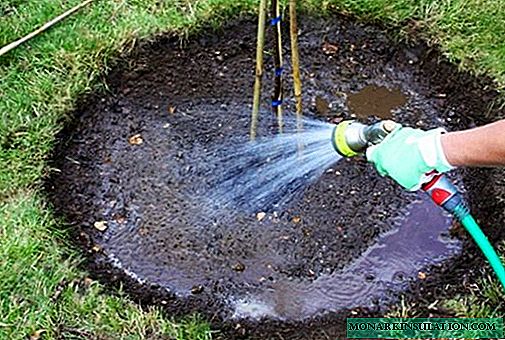
After planting, the seedlings moisten the soil well so that it fits snugly against the roots and there are no air sinuses left in it.
- After a while, when the soil dries up, it is loosened and mulched with hay, humus, rotted sawdust, etc.
- The central conductor is cut to a height of 60-80 centimeters, and the branches are shortened by half.
Features of cultivation and subtleties of care
Of course, in order to grow any tree, you need to make some effort. Pear Moskvichka does not require leaving something extraordinary. For its cultivation, it is quite enough to have standard knowledge of agricultural technology of fruit crops.
Watering
This important stage of pear care consists in regular watering, ensuring constant soil moisture in the root zone. Watering is usually started in spring if rainfall is not frequent enough at this time. As a rule, pear is first watered before flowering, and then during the season with an interval of 3-4 weeks. The amount of water consumed in this case should be sufficient to moisten the soil of the trunk circle to a depth of 25-35 centimeters. Often, gardeners, loosening the soil after the first watering, mulch it with hay, humus, rotted sawdust, sunflower husk, etc. Later on, water the tree through a layer of this mulch, without undertaking additional loosening of the soil. It is convenient, saves time and effort. Only sometimes you need to monitor the condition of the mulch, because it can collect slugs, grubs and other pests. Having discovered, they should be collected and destroyed. It is advisable to free the trunk circle from the mulch and dry it. The next watering, you can resume mulching. Not forgetting the tendency of the pear to rotate the roots and the stem, you should protect them with an earthen roller from direct contact with water when watering.

The soil after watering is mulched
Top dressing
An equally important stage of care is top dressing. After all, if the pear does not have enough food or water, it often just drops ovaries or fruits. Therefore, after three to four years after planting (until this time, there is still enough nutrition laid in the planting pit), they begin additional fertilizer application.
Table: when and how to fertilize a pear
| When fertilize | Than fertilize | How much fertilizer is used | How to fertilize |
| In the spring | Organic fertilizers (humus, compost, peat) | 5-7 kg / m2 | Spread evenly over the area of the near-stem circle and dig it up, planting it in the soil |
| Nitrogen-containing mineral fertilizers (ammonium nitrate, urea, nitroammophoska) | 20-30 g / m2 | ||
| The end of spring-the beginning of summer | Potassium-containing mineral fertilizers (potassium sulfate, potassium monophosphate) | 10-20 g / m2 | Dissolve in water and apply when watering |
| During the period of growth and ripening of fruits | Liquid organic food in the form of infusions | 1 l / m2 concentrated infusion. Feeding is repeated 3-4 times with an interval of 2-3 weeks. | A concentrated infusion of organic matter is prepared (2 liters of mullein, 1 liter of bird droppings or 5-7 kg of freshly cut grass) in ten liters of warm water. Insist in a warm place for 5-7 days and diluted with water in a ratio of 1 to 10. |
| Fall | Mineral phosphorus fertilizers (superphosphate, supegro) | 20-30 g / m2 | Spread evenly over the area of the near-stem circle and dig it up, planting it in the soil |
| Complex mineral fertilizers are used according to the instructions | |||
Trimming
This is the third, but not least, pear care step.
Pear crown formation Muscovite
Due to the medium height of the tree, it is better to form the crown of the Muscovite as an improved bowl. This method allows you to better illuminate the inside of the crown and create good ventilation. And also care and harvesting is facilitated. To carry out such a formation is easier than sparse-tier. Even a beginner gardener can do this if he follows the following instructions:
- We remind you that the first step of forming is performed when planting a seedling, as described above.
- 1-2 years after planting, in the early spring before the onset of sap flow, 3-4 strong branches are selected on the trunk. They should be from each other at a distance of 15-20 centimeters and grow in different directions. These branches will become skeletal. They are cut to a third of the length.
- All remaining branches are cut "into a ring."
- The central conductor is cut off above the base of the upper skeletal branch.
- After another one or two years, when the skeletal branches begin to grow, you should choose two branches of the second order on each of them. The distance between them should be within 50-60 centimeters. They are shortened by 50%, and the remaining branches that grew on skeletal are removed in the same way "on the ring."
- In other years, the length of branches is maintained at approximately the same level. One of them must not be allowed to dominate and assume the role of a central conductor - this sometimes happens.
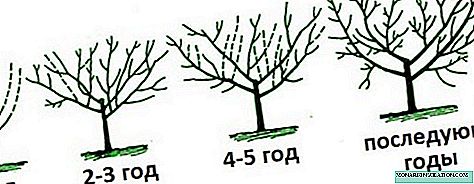
Krona Moskvichki better form in the form of an improved bowl
Adjust cropping
Muscovite is prone to excessive thickening. Due to this feature, it requires frequent thinning of the crown. Most likely, this will have to be done every spring. At the same time, part of the branches growing inside the crown is cut out, creating good ventilation and illumination. But you should know the measure - excessive pruning deprives part of the crop, as flower buds are also located on the inner branches.
Video: Dmitry Reznikov pear pruning method
Support Crop
To maintain fruiting at the proper level, supportive pruning is required. In the summer, during the period of increased growth of young shoots, they are shortened by 5-10 centimeters, which leads to the appearance of additional sprouting branches on them. It is on such branches that flower buds are laid, which give a harvest. This relatively simple method gives good results, but more experienced gardeners use a different method, which consists in replacing the fertilized shoots with substitution shoots. This method is widely used for pruning grapes.

Experienced gardeners apply the method, which consists in replacing the fertilized shoots with substitution shoots
Sanitary pruning
This simplest type of pruning involves the removal of dry, diseased and damaged branches. Spend it in late autumn, after stopping sap flow. If necessary, repeat the wounds in the spring.
Crop Rules
These rules apply to all types of trim. They must be observed so as not to harm the tree.
- You need to use only sharpened tools (secateurs, delimbers, knives, saws).
- When performing work, the tool should be disinfected with a 1% solution of copper sulfate (you can use hydrogen peroxide, alcohol, etc.). It is impossible to use oil products for this - gasoline, kerosene, solvent, etc.
- Cutting off branches completely, you can not leave knots or hemp - later they will become a source of infections.
- When removing thick branches, you need to do this in parts, in a few tricks.
- All sections are cleaned with a sharp knife and covered with garden var. This rule can not be applied to branches with a diameter of less than ten millimeters.
When choosing a garden var, do not dwell on one that includes petrolatum or other oil products. Experienced gardeners indicate that it is harmful to the plant. There are compounds based on beeswax, lanolin and other biological materials - they should be preferred.
Diseases and pests - the main representatives, prevention and control methods
Performing simple preventive measures, you can avoid the defeat of almost all known diseases and pests of pear trees.
Preventive measures
Regularly performing sanitary and preventive maintenance in the garden is easier than fighting the effects of fungal infections or insect attacks. The list of such works includes:
- Keeping the garden clean. After the end of leaf fall, they must rake up all the fallen leaves, weeds, and other plant debris into a pile. There is no doubt that in such a heap there will be pests that have settled for the winter, as well as fungal spores. Therefore, such a pile is burned without regret, while receiving a certain amount of ash, which is an excellent fertilizer.
- Before leaving in the winter should inspect the bark of trees. If cracks and damage are found, they should be cleaned and cut to healthy wood. After that, treat with 1% solution of copper sulfate and cover with a layer of garden var.
- And also before leaving for the winter, trunks and thick branches are whitened with a solution of slaked lime with the addition of 1% copper sulfate. Alternatively, use commercially available special garden paints. Such whitewashing protects the bark from sunburn and prevents the movement of insect pests on it.
- Deeply dig the soil of near-stem circles, doing this before the onset of frost. In this case, wintering pests raised from the lower layers of the soil should die from the cold.
- Then, soil and tree crowns are treated with a 3% solution of copper sulfate or Bordeaux mixture. The same treatment is carried out in early spring.
- In order to prevent caterpillars, ants, weevils and other insects from getting onto the crown, in early spring, a hunting belt made of a strip of roofing material, film, burlap, etc. is strengthened on a tree trunk.
- At the same time, potent pesticides are treated. Apply DNOC - once every three years. In the remaining years, Nitrafen is used.
- When the pear blooms, preventive spraying with systemic fungicides begins. Spend them with an interval of 2-3 weeks. Especially important are such treatments after rains, when there is increased humidity, creating favorable conditions for fungi. Apply such drugs as Skor, Horus, Quadrice, Ridomil Gold and others. You need to remember about the addiction of fungi to drugs. After three treatments with one drug, its effectiveness decreases, so they should be alternated.
Possible diseases
Like other fruit crops, pears are most susceptible to fungal diseases. As indicated in the description of the variety, Muscovite is resistant to scab and fruit rot, but the likelihood of illness is not excluded. For the fight and prevention, the drugs shown in the table above are used.
Moniliosis
This disease is caused by a fungus, whose spores usually fall into the flowers on the legs of bees during the collection of nectar. It is clear that the flowers are the first to be affected. Then the fungus spreads to shoots and leaves. The affected parts of the plant will fade and blacken. From the side it looks like a frostbite or a burn. Due to this similarity, this disease received a second name - a monilial burn. If such signs are found, the affected shoots are cut out first and destroyed. At the same time, they capture 20-30 centimeters of healthy wood - the fungus could already move there. In the summer, the fungus infects the fruits of the pear with gray fruit rot. Such fruits are harvested and destroyed.

In summer, moniliosis affects pear fruit with gray rot
Scab
A sign of this disease is the appearance of olive-colored spots on the leaves of the pear. When the fruit is affected, putrefactive spots form, the skin crackes, the flesh becomes hard. Such fruits are no longer suitable for food. Affected leaves and fruits should be collected and destroyed.

When the fruit of the pear is affected, putrefactive spots form, the skin crackes, the flesh becomes hard
Soot fungus
The appearance of a black, soot-like coating on the leaves and fruits of a pear is a sign of this disease. But usually this is preceded by an aphid attack. Aphids in the process of life emit a sweet liquid, which becomes a breeding ground for soot fungus.

The appearance of a black, soot-like coating on the leaves and fruits of a pear is a sign of a soot fungus
Likely Pests
Without the preventative measures described above, pest damage is very likely. For the prevention and control of insects, insecticides are used, for example, Decis, Fufanon, Spark, Spark Bio and others.
Aphid
These small insects are brought onto the crown by ants, who, like the sooty fungus, love to feast on its sweet secretions. Therefore, creating obstacles for ants and other insects to fall on the tree’s crown, the gardener will protect the pear from aphid damage and not only.

Aphids are carried on a tree by ants
Pear moth
Caterpillars of the butterfly moth cannot crawl onto a tree if its trunk is whitewashed and a hunting belt is installed on it. Caterpillars that have penetrated the crown gnaw at the fruit and crawl into them to feed on the tender flesh. At this time, the fight against them will no longer have an effect.

Codling moth caterpillars are taken out from eggs laid by a butterfly in the soil
Pear beetle
This weevil beetle hibernates in the soil and in early spring, when the earth begins to warm up, crawls out and rises along the trunk to the crown (if it is not disturbed by whitewashing and the hunting belt). Then the beetles begin to eat out flower buds and flowers. If the gardener found yellowed flowers and wrinkled buds - most likely, this worked as a pear beetle. In early spring, when in the morning the air temperature does not exceed +5 ° C, the flower beetles sit on branches in a state of stupor. At this time, you can simply shake them on a pre-lined fabric or film.

A pear beetle hibernates in the soil and early in the spring, when the earth begins to warm up, crawls out and rises along the trunk to the crown
Grade Reviews
And your Muscovite is worse than this, it is one of the best varieties, and in terms of fruit size there are few varieties that grow in the Moscow Region that can be compared.
Natalia, Moscow
//www.websad.ru/archdis.php?code=34833
Muscovite and tastier and bigger, but already ate, and not stored for long. I want delicious, autumn, so that until December, enough!
Ninulia, Nizhny Novgorod
//www.tomat-pomidor.com/newforum/index.php?topic=2061.80
I like the Muscovite from later ones, it grows among our neighbors. They collect it in the second half of September, spread it out on the second floor and it can be stored for a month, but the latter, of course, are already becoming a little “cotton”, and the ripe freshly picked sweet, juicy and with a small bitterness are so pleasant.
Galya-64, Vladimir
//www.tomat-pomidor.com/newforum/index.php?topic=2061.80
I advise you to pay attention to the autumn variety Moskvichka, really liked the pears. In 2015, they ripened in late September after Chizhovskaya and Pamyat Yakovlev, it seemed that they would be well stored (it was not enough, everyone ate it in 2-3 weeks). Now I have a Muscovite vaccinated with a skeletal branch on Chizhovskaya, I can cut the stalk for you.
Tamara St. Petersburg
//www.vinograd7.ru/forum/viewtopic.php?p=360820
I support Tamara. If it ripens well in St. Petersburg, then this is an excellent variety. My pear Moskvichka has been growing for over 30 years. I’m not overjoyed at her. Pears ripen well every year, tasty, oily flesh, medium and large fruits, beautiful, well stored - in the refrigerator for about 3 months. For storage, it is better to remove the fruits in the green and they reach ripeness in lying. High yield and good fruit setting, however, with a large yield, the fruits are smaller. Among the shortcomings, I want to note the high growth of the tree and the sharp departure of bitches from the trunk. When forming a young seedling, you need to pay attention to this. He planted another tree of this grade of his vaccination.
Vic, Zavidovo
//www.vinograd7.ru/forum/viewtopic.php?p=360820
Hello! My pear Moskvichka is growing. She is 10 years old, blooms abundantly, bears fruit regularly, only this is the problem, the fruits in an unripened state resemble potatoes to taste, and when they ripen, they become cottony. There is no juiciness in them :(, although people who grow such a variety claim that the pulp is juicy! Maybe something is missing?
Yana, Moscow region
//forum.tvoysad.ru/viewtopic.php?t=181&start=120
We have a young Muscovite gave gorgeous crops, pollinating with old-aged Bergamot (or what else is called a pear with green round fruits?). We deliberately did not look for a couple of them. And Moskvichka’s pears are really delicious (for me, both Lada and Chizhovskaya are tastier)
Natali_R, Moscow
//www.forumhouse.ru/threads/16572/page-40
The Moskvichka pear variety has several advantages, due to which it has earned popularity among amateur gardeners. He also enjoys no less interest among farmers who are attracted by productivity, stubbornness and relatively good transportability of fruits. It may well be recommended for cultivation, if there are favorable conditions for this.






